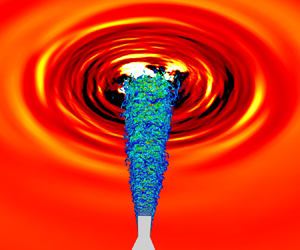Article contents
Large-eddy simulations of the noise control of supersonic rectangular jets with bevelled nozzles
Published online by Cambridge University Press: 24 January 2025
Abstract

The bevelled nozzle is a promising noise control approach and has been tested to suppress the noise levels in supersonic circular jets, but not in rectangular jets so far. In this study, implicit large-eddy simulations are performed to analyse the noise control of supersonic rectangular jets with single- and double-bevelled nozzles. Three nozzle pressure ratios ( $NPR = 2.3$, 3.0 and 5.0) are considered to form two over-expanded cold jets and one under-expanded cold jet, exhausted from a baseline convergent–divergent rectangular nozzle with an aspect ratio of 2.0. Results show that, with the increase of
$NPR = 2.3$, 3.0 and 5.0) are considered to form two over-expanded cold jets and one under-expanded cold jet, exhausted from a baseline convergent–divergent rectangular nozzle with an aspect ratio of 2.0. Results show that, with the increase of  $NPR$, the oscillation of the jet plume is switched from a symmetrical mode to a flapping mode (preferential in the minor-axis plane), then to a helical mode, together with a reduction of the screech frequency. The amplitude of the screech tone is the strongest in the flapping jet, and the turbulent mixing noise is the most prominent in the helically oscillating jet. The single-bevelled nozzle induces asymmetric shock-cell structures and deflects the jet plumes, and the double-bevelled nozzle primarily enables the enhancement of the shear-layer mixing and shortens the lengths of the jet potential cores. With the bevelled nozzles, the gross thrusts of the baseline nozzle are increased by
$NPR$, the oscillation of the jet plume is switched from a symmetrical mode to a flapping mode (preferential in the minor-axis plane), then to a helical mode, together with a reduction of the screech frequency. The amplitude of the screech tone is the strongest in the flapping jet, and the turbulent mixing noise is the most prominent in the helically oscillating jet. The single-bevelled nozzle induces asymmetric shock-cell structures and deflects the jet plumes, and the double-bevelled nozzle primarily enables the enhancement of the shear-layer mixing and shortens the lengths of the jet potential cores. With the bevelled nozzles, the gross thrusts of the baseline nozzle are increased by  $0.05 \sim 7.38$ %. Details on the characteristics of far-field noise in the jets with/without the bevel cuts and their noise control mechanisms are discussed using the Ffowcs Williams–Hawkings acoustic analogy, dynamic mode decomposition and spatio-temporal Fourier transformation. Results suggest that the noise control has a close relationship with the destruction of well-organized coherent structures and the suppression of upstream-propagating guided-jet modes, which interrupt the feedback mechanism accounting for the generation of screech tones in the supersonic rectangular jets.
$0.05 \sim 7.38$ %. Details on the characteristics of far-field noise in the jets with/without the bevel cuts and their noise control mechanisms are discussed using the Ffowcs Williams–Hawkings acoustic analogy, dynamic mode decomposition and spatio-temporal Fourier transformation. Results suggest that the noise control has a close relationship with the destruction of well-organized coherent structures and the suppression of upstream-propagating guided-jet modes, which interrupt the feedback mechanism accounting for the generation of screech tones in the supersonic rectangular jets.
JFM classification
Information
- Type
- JFM Papers
- Information
- Copyright
- © The Author(s), 2025. Published by Cambridge University Press
References
- 2
- Cited by


